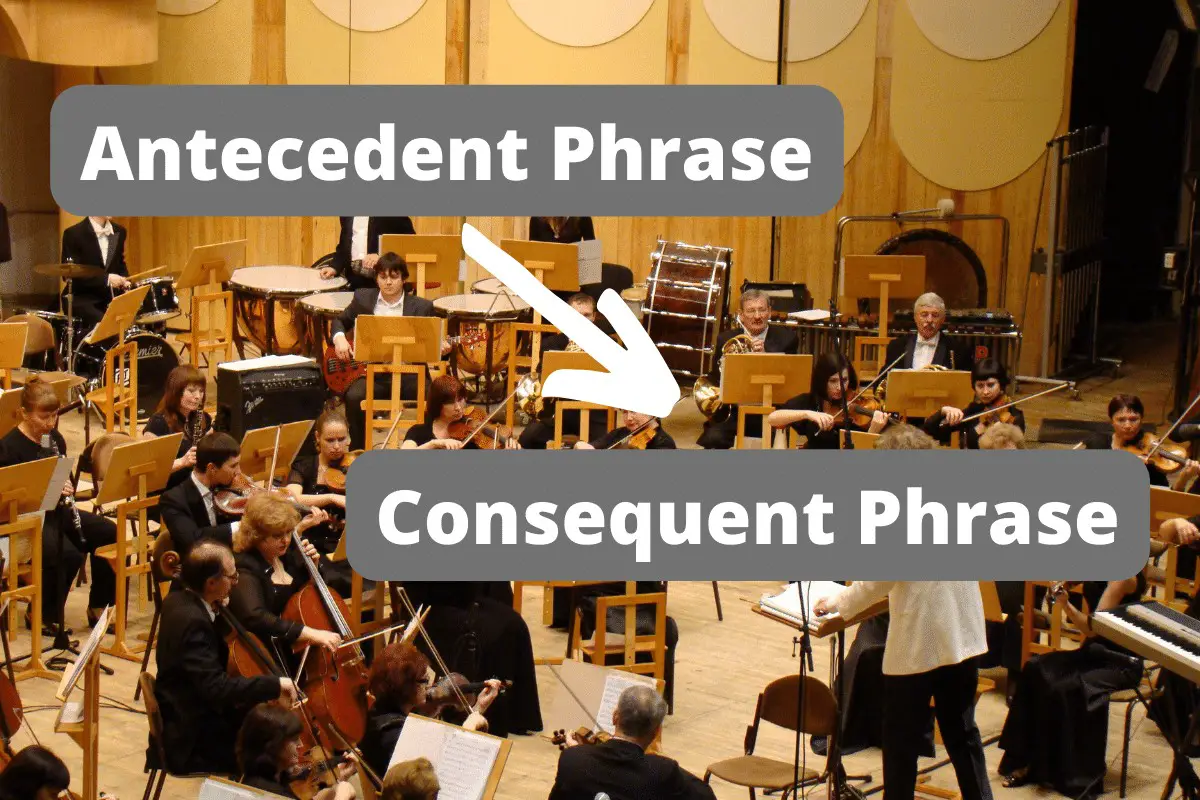As I’ve gotten into music more and more over the past…few decades…I’m always surprised by the ways composers and songwriters craft melodies and phrases in such amazing ways.
Even as a music teacher, I always like to go back to my books and training to help me understand what makes music so awesome.
This is where I came back across the idea of antecedent phrases and consequent phrases in music.
Antecedent and consequent phrases in music are complimentary phrases, also known as question and answer by some. Antecedent phrases feature a weak cadence, and the consequent phrase finishes the thought with a strong cadence.
These types of phrases are found in both classical music and popular music.
As with most music theory ideas, this is complex at first, but a strong understanding will improve your appreciation of music.
Table of Contents
Antecedent Phrase Meaning In Music
There are usually two parts or phrases in a musical period (think of it as a sentence).
The antecedent phrase often happens at the start of a piece and features a weak cadence.
It leaves the music feeling incomplete or unfinished.
This tension drives the music forward into the second phrase.
The second phrase, often called the consequent phrase, features a stronger cadence and leaves you with a better feeling of resolution.
Traditionally, antecedent phrases use weaker cadences like:
- Half cadence – End on the V or Dominant chord rather than the ideal I or tonic chord
- Deceptive cadence – Instead of going to the I (tonic) from V or V7, we move the related but weaker vi or iii.
Consequent Phrase In Music
A consequent phrase is often similar to the antecedent, but it resolves more strongly.
It finishes with a more satisfying cadence but not necessarily an authentic cadence every time.
If the composer or songwriter wants to propel the music forward, even more, they can use an imperfect cadence.
This helps resolve the previous phrase without making the song sound too finished.
At this point, the composer either finishes the song or starts the next period.
Naturally, this is a pretty simplistic explanation of a complex topic, but the ideas stay the same for almost all music.
Some composers will even stack multiple antecedent phrases on top of each other to drive the tension further forward.
However, a lot of music will stick with the standard, two-part question and answer combination.
8-Bit music theory does a great and quick video on these phrases.
Examples Of Antecedent Phrase And Consequent Phrase
For a good example of this, let’s look at the well-known period from Beethoven’s 9th Symphony and the theme, Ode To Joy.
Here, I arranged it into the key of C Major to show what I’m talking about easier here.
Let’s take a look at the first phrase.

What a beautiful melody! But it doesn’t satisfy us to leave it like this, does it?
It has to do with what sounds complete to our ears.
The home tone, C, sounds the most complete in this key. We could get away with a G if the harmony was correct, but in this antecedent phrase, we end on D, the second tone of the scale.
Imagine never hearing the ending of this phrase. I know it would hand with me for ages.
For every question, there is an answer.
Let’s take a look at the second phrase.

Now, we see the iconic consequent phrase.
Notice how it traditionally uses many of the same rhythmic and melodic elements as its antecedent cousin.
In fact, the last few notes are the only changes.
Beethoven ends the phrase on the tonic (in this key, C), ending the period.
Listen to the entire phrase played in the section below and notice how it sounds so complete.
From here, Beethoven develops the period and adds more ideas to the piece.
Have a listen to the 4th movement of Beethoven’s 9th and final Symphony.
This is where the Ode to Joy is featured.
Yeah, it’s fairly long, but it’s well worth a listen.
See if you can hear any repetitive phrases where the first time sounds incomplete and the second sounds finished.
That’s your clue!
What Is The Antecedent And Consequent Phrase Of Mary Had A Little Lamb?
If you want an even more simple and effective example, take a look at Mary Had A Little Lamb.
Notice how the first part ends on the motion, E-G-G.
This isn’t the motion we usually look for in going to our I or tonic chord (C in the key of C Major).
But the second phrase uses a lot of the same melodic ideas. Even the words are the same in the beginning!
Can Rhythms Affect Antecedent And Consequent Phrases?
Rhythms aren’t enough on their own to indicate the type of phrase, but rhythms are a big help in accentuating the difference.
We tend to hear long rhythms as finished thoughts. These would be things like half notes or quarter notes in duple meter or dotted half notes or dotted quarter notes in triple meter.
Even little things like tempo make a difference.
Antecedent phrases often stay in tempo, but there will sometimes be a slight slow down (or ritardando) at major consequent phrases.
Of course, this is usually followed by an “a tempo.”
Learn more about a tempo in music by checking out our article on this aspect of music theory here.

